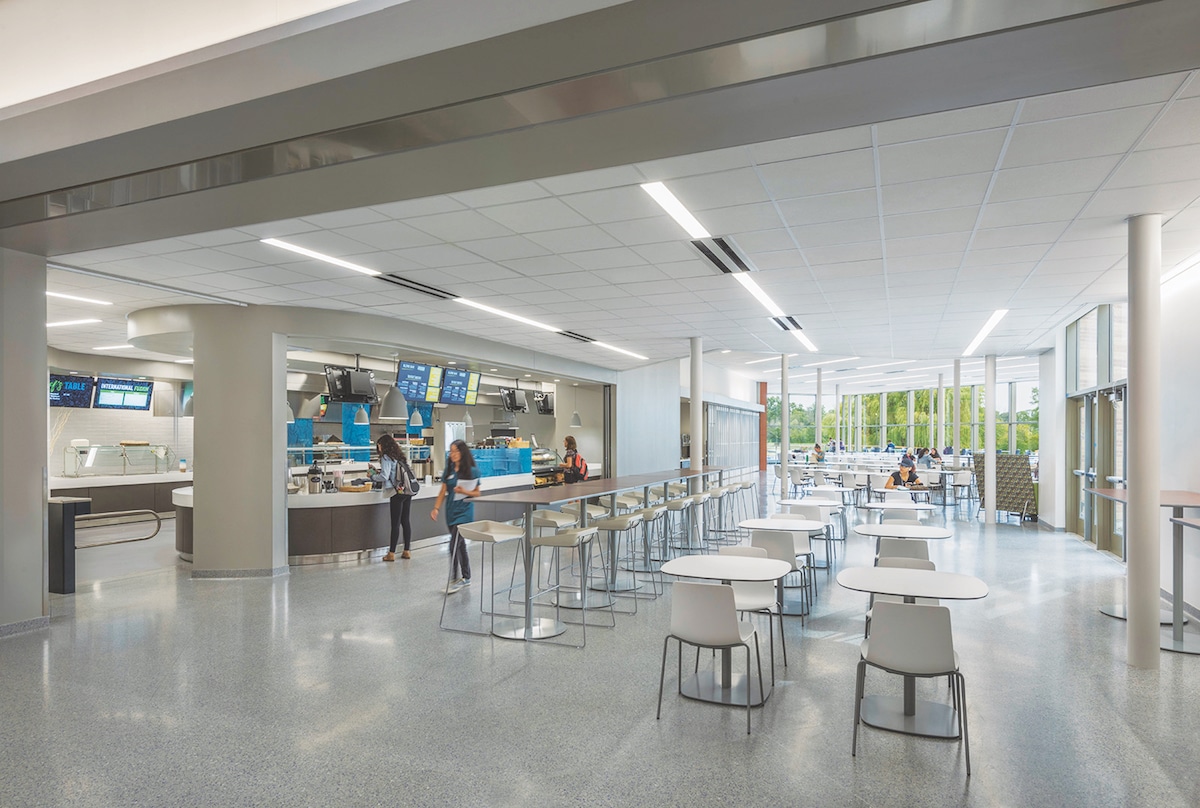
Willow Café at the College of Lake County, renovated by Legat Architects, features aspects of wellness design like abundant natural light and great views of nature. [Photo: Connor Steinkamp, Steinkamp Photo]
The concept of sustainability evolves with each new market trend and application. In recent years, the corporate world shifted its focus firmly and deliberately to the subject of human health and wellness. Defined as core elements of sustainability and healthy buildings, these trends will revolutionize how we design, operate, and evaluate the built environments in which we live and work.
Wellness Design
Major factors in the growth of the U.S. health and wellness market are a growing focus on work-life balance, the promotion of regular sleep, exercise, and healthy eating habits, and concerns about high obesity rates and increasing health care costs. According to the Global Wellness Institute, it was estimated that the worldwide wellness industry grew to $3.72 trillion between 2013 and 2015, making it one of the world’s fastest growing markets. During the same period, the most rapidly developing sectors within the global wellness market were the workplace wellness industry ($43.3 billion) and the global wellness real estate market ($118.6 billion).
Occupant health and wellness have always been core components of any successfully executed sustainable building design. The initial green building standards like LEED and the Living Building Challenge (LBC) addressed building occupant health and wellness through a variety of prerequisites, prescriptive design measures, and design imperatives. Early on, the LEED rating methodology incentivized the use of natural light, increased ventilation, application of CO2 sensors, and reduction of volatile organic compounds. In contrast to LEED, the LBC emphasized on-site food production, biophilia, beauty, and the elimination of known carcinogens from construc-
tion materials.
WELL & Fitwel
Launched in 2014, the WELL Building Standard (WELL) was the first building standard to focus exclusively on the health and wellness of building occupants. Operated by the International WELL Building Institute, WELL aims to combine best practices in building design with evidence-based scientific research. The resulting system consists of seven unique categories, including preconditions and optimization features that resemble the LEED rating system structure. WELL uses the built environment to support health and wellbeing and is intended to work in harmony with LEED and the LBC. However, the relatively high cost of certification and the two-year recertification requirement may prove challenging for some building owners and are potential barriers to wider market adoption.
Fitwel, the latest certification system created in 2015, was a product of collaboration between the U.S. Centers for Disease Control and Prevention (CDC) and the General Services Administration. Their goal was to create a measurement system that is easy for building owners and is backed by research and evidence. According to the CDC, the system is supported by more than 3,000 cast studies by the organization and was developed by consulting a broad group of experts in design, public health, and building management. The certification system includes seven key strategies grouped into 12 sections and has no prerequisites. In 2016, the Center for Active Design took over as the licensed operator of Fitwel, to lead any future development and use within the private and public sectors.
For the professional design community, the increasing complexity of issues that sustainable building design is required to tackle can be daunting at times. On the upside, the latest developments offer an opportunity for growth, reinvention, and development of new sustainable design competencies and services.
Read more gb&d wellness-based design articles.
 Vuk Vujovic is principal and director of sustainability and energy at Legat Architects in Chicago, leading the integration of architectural design, sustainability, energy, climate action planning, and resiliency. He is also an associate director of the AIA Chicago chapter, a member of the International Living Building Institute, and former chair of AIA Chicago’s Committee on the Environment.
Vuk Vujovic is principal and director of sustainability and energy at Legat Architects in Chicago, leading the integration of architectural design, sustainability, energy, climate action planning, and resiliency. He is also an associate director of the AIA Chicago chapter, a member of the International Living Building Institute, and former chair of AIA Chicago’s Committee on the Environment.
